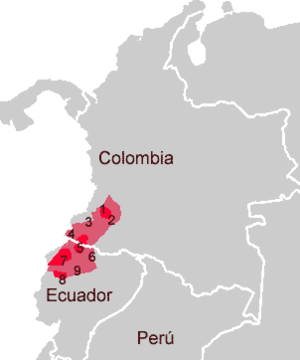Barbacoan languages
| Barbacoan | |
|---|---|
| Geographic distribution: | Colombia and Ecuador |
| Linguistic classification: | One of the world's primary language families |
| Subdivisions: |
|
| Glottolog: | barb1265[1] |
|
Barbacoan language at present, and probable areas in the 16th century:
| |
Barbacoan (also Barbakóan, Barbacoano, Barbacoana) is a language family spoken in Colombia and Ecuador.
Languages
Barboacoan consists of 6 languages:
- Northern
- Awan (also known as Awa or Pasto)
- Awa Pit (also known as Cuaiquer, Coaiquer, Kwaiker, Awá, Awa, Telembi, Sindagua, Awa-Cuaiquer, Koaiker, Telembí)
- Pasto–Muellama
- Coconucan (also known as Guambiano–Totoró)
- Southern ? (Cayapa–Tsafiki)
- Caranqui (also known as Cara, Kara, Karanki, Imbaya) (†)
- Cha’palaachi (also known as Cayapa, Chachi, Kayapa, Nigua, Cha’pallachi)
- Tsafiki (also known as Colorado, Tsafiqui, Tsáfiki, Colorado, Tsáchela, Tsachila, Campaz, Colima)
Pasto, Muellama, Coconuco, and Caranqui are now extinct.
Pasto and Muellama are usually classified as Barbacoan, but the current evidence is weak and deserves further attention. Muellama may have been one of the last surviving dialects of Pasto (both extinct, replaced by Spanish) — Muellama is known only by a short wordlist recorded in the 19th century. The Muellama vocabulary is similar to modern Awa Pit. The Cañari–Puruhá languages are ever more poorly attested, and while often placed in a Chimuan family, Adelaar (2004:397) thinks they may have been Barbacoan.
The Coconucan languages were first connected to Barbacoan by Daniel Brinton in 1891. However, a subsequent publication by Henri Beuchat and Paul Rivet placed Coconucan together with a Paezan family (which included Páez and Paniquita) due a misleading "Moguex" vocabulary list. The "Moguex" vocabulary turned out to be a mix of both Páez and Guambiano languages (Curnow 1998). This vocabulary has led to misclassifications by Greenberg (1956, 1987), Loukotka (1968), Kaufman (1990, 1994), and Campbell (1997), among others. Although Páez may be related to the Barbacoan family, a conservative view considers Páez a language isolate pending further investigation. Guambiano is more similar to other Barbacoan languages than to Páez, and thus Key (1979), Curnow et al. (1998), Gordon (2005), and Campbell & Grondona (2012) place Coconucan under Barbacoan. The moribund Totoró is sometimes considered a dialect of Guambiano instead of a separate language, and, indeed, Adelaar & Muysken (2004) state that Guambiano-Totoró-Coconuco is best treated as a single language.
The Barbácoa (Barbacoas) language itself is unattested, and is only assumed to be part of the Barbacoan family. Nonetheless, it has been assigned an ISO code, though the better-attested and classifiable Pasto language has not.
Genealogical relations
The Barbacoan languages may be related to the Páez language. Barbacoan is often connected with the Paezan languages (including Páez); however, Curnow (1998) shows how much of this proposal is based on misinterpretation of an old document of Douay (1888). (See: Paezan languages.)
Other more speculative larger groupings involving Barbacoan include the Macro-Paesan "cluster", the Macro-Chibchan stock, and the Chibchan-Paezan stock.
See also
References
- ↑ Nordhoff, Sebastian; Hammarström, Harald; Forkel, Robert; Haspelmath, Martin, eds. (2013). "Barbacoan". Glottolog. Leipzig: Max Planck Institute for Evolutionary Anthropology.
Bibliography
- Adelaar, Willem F. H.; & Muysken, Pieter C. (2004). The languages of the Andes. Cambridge language surveys. Cambridge University Press.
- Brend, Ruth M. (Ed.). (1985). From phonology to discourse: Studies in six Colombian languages (p. vi, 133). Language Data, Amerindian Series (No. 9). Dallas: Summer Institute of Linguistics.
- Beuchat, Henri; & Rivet, Paul. (1910). Affinités des langues du sud de la Colombie et du nord de l'Équateur. Le Mouséon, 11, 33-68, 141-198.
- Campbell, Lyle. (1997). American Indian languages: The historical linguistics of Native America. New York: Oxford University Press. ISBN 0-19-509427-1.
- Constenla Umaña, Adolfo. (1981). Comparative Chibchan phonology. (Doctoral dissertation, University of Pennsylvania).
- Constenla Umaña, Adolfo. (1991). Las lenguas del área intermedia: Introducción a su estudio areal. San José: Editorial de la Universidad de Costa Rica.
- Constenla Umaña, Adolfo. (1993). La familia chibcha. In (M. L. Rodríguez de Montes (Ed.), Estado actual de la clasificación de las lenguas indígenas de Colombia (pp. 75–125). Bogotá: Instituto Caro y Cuervo.
- Curnow, Timothy J. (1998). Why Paez is not a Barbacoan language: The nonexistence of "Moguex" and the use of early sources. International Journal of American Linguistics, 64 (4), 338-351.
- Curnow, Timothy J.; & Liddicoat, Anthony J. (1998). The Barbacoan languages of Colombia and Ecuador. Anthropological Linguistics, 40 (3).
- Douay, Léon. (1888). Contribution à l'américanisme du Cauca (Colombie). Compte-Rendu du Congrès International des Américanistes, 7, 763-786.
- Gerdel, Florence L. (1979). Paez. In Aspectos de la cultura material de grupos étnicos de Colombia 2, (pp. 181–202). Bogota: Ministerio de Gobierno and Instituto Lingüístico de Verano.
- Kaufman, Terrence. (1990). Language history in South America: What we know and how to know more. In D. L. Payne (Ed.), Amazonian linguistics: Studies in lowland South American languages (pp. 13–67). Austin: University of Texas Press. ISBN 0-292-70414-3.
- Kaufman, Terrence. (1994). The native languages of South America. In C. Mosley & R. E. Asher (Eds.), Atlas of the world's languages (pp. 46–76). London: Routledge.
- Key, Mary R. (1979). The grouping of South American languages. Tübingen: Gunter Narr Verlag.
- Landaburu, Jon. (1993). Conclusiones del seminario sobre clasificación de lenguas indígenas de Colombia. In (M. L. Rodríguez de Montes (Ed.), Estado actual de la clasificación de las lenguas indígenas de Colombia (pp. 313–330). Bogotá: Instituto Caro y Cuervo.
- Loukotka, Čestmír. (1968). Classification of South American Indian languages. Los Angeles: Latin American Studies Center, University of California.
- Slocum, Marianna C. (1986). Gramática páez (p. vii, 171). Lomalinda: Editorial Townsend.
- Stark, Louisa R. (1985). Indigenous languages of lowland Ecuador: History and current status. In H. E. Manelis Khan & L. R. Stark (Eds.), South American Indian languages: Retrospect and prospect (pp. 157–193). Austin: University of Texas Press.
External links
- Proel: Familia Barbacoana
- Proel: Sub-tronco Paezano
